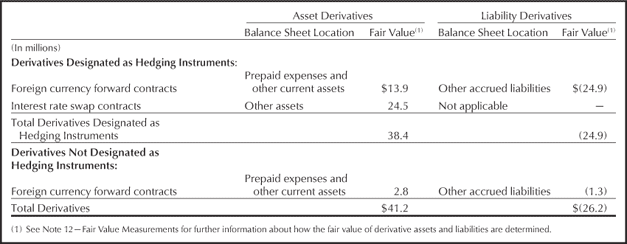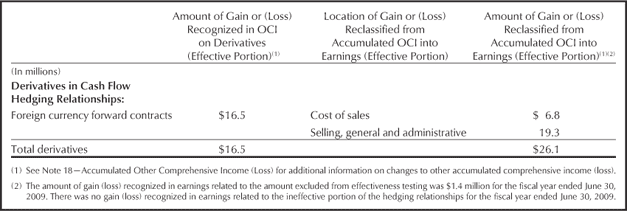NOTE 11 - DERIVATIVE FINANCIAL INSTRUMENTS
The Company addresses certain financial exposures
through a controlled program of risk management that
includes the use of derivative financial instruments. The
Company primarily enters into foreign currency forward
and option contracts to reduce the effects of fluctuating
foreign currency exchange rates and interest rate derivatives
to manage the effects of interest rate movements on
the Company's aggregate liability portfolio. The Company
also enters into foreign currency forward and option contracts,
not designated as hedging instruments, to mitigate
the change in fair value of specific assets and liabilities on
the balance sheet. The Company does not utilize derivative
financial instruments for trading or speculative purposes.
Costs associated with entering into these derivative
financial instruments have not been material to the
Company's consolidated financial results.
For each derivative contract entered into where the
Company looks to obtain special hedge accounting treatment,
the Company formally documents all relationships
between hedging instruments and hedged items, as well
as its risk-management objective and strategy for undertaking
the hedge transaction, the nature of the risk being
hedged, how the hedging instruments' effectiveness in
offsetting the hedged risk will be assessed prospectively
and retrospectively, and a description of the method of
measuring ineffectiveness. This process includes linking all
derivatives to specific assets and liabilities on the balance
sheet or to specific firm commitments or forecasted
transactions. The Company also formally assesses, both at
the hedge's inception and on an ongoing basis, whether
the derivatives that are used in hedging transactions are
highly effective in offsetting changes in fair values or cash
flows of hedged items. If it is determined that a derivative
is not highly effective, or that it has ceased to be a highly
effective hedge, the Company will be required to
discontinue hedge accounting with respect to that derivative
prospectively.
The fair values of the Company's derivative financial instruments included in the consolidated balance sheet as of June 30,
2009 are presented as follows:

The amounts of the gains and losses related to the Company's derivative financial instruments designated as hedging
instruments for the year ended June 30, 2009 are presented as follows:


The amounts of the gains and losses related to the Company's derivative financial instruments not designated as hedging
instruments for the year ended June 30, 2009 are presented as follows:

Foreign Currency Cash-Flow Hedges
The Company enters into foreign currency forward
contracts to hedge anticipated transactions, as well as
receivables and payables denominated in foreign currencies,
for periods consistent with the Company's identified
exposures. The purpose of the hedging activities is to
minimize the effect of foreign exchange rate movements
on costs and on the cash flows that the Company receives
from foreign subsidiaries. The majority of foreign currency
forward contracts are denominated in currencies of major
industrial countries. The Company also enters into foreign
currency option contracts to hedge anticipated transactions
where there is a high probability that anticipated
exposures will materialize. The foreign currency forward
contracts entered into to hedge anticipated transactions
have been designated as foreign currency cash-flow
hedges and have varying maturities through the end of
June 2010. Hedge effectiveness of foreign currency forward
contracts is based on a hypothetical derivative methodology
and excludes the portion of fair value attributable
to the spot-forward difference which is recorded in
current-period earnings. Hedge effectiveness of foreign
currency option contracts is based on a dollar offset methodology.
The ineffective portion of both foreign currency
forward and option contracts is recorded in current-period
earnings. For hedge contracts that are no longer deemed
highly effective, hedge accounting is discontinued and
gains and losses accumulated in other comprehensive
income (loss) are reclassified to earnings when the underlying
forecasted transaction occurs. If it is probable that
the forecasted transaction will no longer occur, then any
gains or losses in accumulated other comprehensive
income (loss) are reclassified to current-period earnings.
As of June 30, 2009, the Company's foreign currency
cash-flow hedges were highly effective, in all material
respects. The estimated net gain (loss) as of June 30, 2009
that is expected to be reclassified from accumulated other
comprehensive income (loss) into earnings within the
next twelve months is $10.4 million.
At June 30, 2009, the Company had foreign currency
forward contracts in the amount of $1,260.8 million. The
foreign currencies included in foreign currency forward
contracts (notional value stated in U.S. dollars) are principally
the British pound ($239.1 million), Euro ($212.5 million),
Swiss franc ($206.8 million), Canadian dollar ($168.0
million), Hong Kong dollar ($79.4 million), Japanese yen
($76.0 million) and Australian dollar ($69.6 million).
At June 30, 2008, the Company had foreign currency
forward and option contracts in the amount of $1,229.0
million and $64.9 million, respectively. The foreign currencies
included in foreign currency forward contracts
(notional value stated in U.S. dollars) are principally the
Euro ($221.6 million), British pound ($220.7 million),
Swiss franc ($206.5 million), Canadian dollar ($130.0
million), Australian dollar ($91.8 million), Russian ruble
($71.9 million) and Japanese yen ($64.4 million). The
foreign currencies included in the foreign currency option
contracts (notional value stated in U.S. dollars) are
principally the Canadian dollar ($36.8 million) and the
South Korean won ($23.1 million).
Fair Value Hedges
The Company enters into interest rate derivative contracts
to manage its exposure to interest rate fluctuations on its
funded indebtedness and anticipated issuance of debt for
periods consistent with the identified exposures. The
Company has interest rate swap agreements, with a
notional amount totaling $250.0 million, to effectively
convert the fixed rate interest on its 2017 Senior Notes to
variable interest rates based on six-month LIBOR. These
interest rate swap agreements are designated as fair value
hedges of the related long-term debt and the changes in
the fair values of the interest rate swap agreements are
exactly offset by changes in the fair value of the underlying
long-term debt. As of June 30, 2009, these fair-value
hedges were highly effective in all material respects.
Information regarding the Company's interest rate swap
agreements is presented in the following table:

Credit Risk
As a matter of policy, the Company only enters into derivative
contracts with counterparties that have at least an
"A" (or equivalent) credit rating. The counterparties to
these contracts are major financial institutions. Exposure
to credit risk in the event of nonperformance by any of
the counterparties is limited to the gross fair value of contracts
in asset positions, which totaled $41.2 million at
June 30, 2009, of which 42% and 37% were attributable
to two counterparties. To manage this risk, the Company
has established strict counterparty credit guidelines that
are continually monitored and reported to management.
Accordingly, management believes risk of loss under these
hedging contracts is remote.
Certain of the Company's derivative financial instruments
contain credit-risk-related contingent features. As
of June 30, 2009, the Company was in compliance with
such features and there were no derivative financial
instruments with credit-risk-related contingent features
that were in a net liability position.




